Key Takeaways:
Kroger’s app stands out for blending online shopping, digital coupons, loyalty rewards, and tailored suggestions, becoming a one-stop solution.
The market is booming, valued at over USD 600 billion in 2025 and projected to grow rapidly in the future with high user penetration rates.
Steps to build an app like Kroger include market analysis, a clear business model, core features, tech stack, intuitive UI/UX, and secure payments integration.
AI elevates the shopping experience and operations with tailored suggestions, inventory estimates, dynamic pricing, and predictive market analysis.
Revenue of such apps comes from delivery charges, subscriptions, ads, partnerships, pharmacy services, and data monetization.
Kroger app development challenges include complex inventory, security, scalability, and regulatory compliance, which are key to lasting growth.
JPLoft specializes in building custom, scalable grocery delivery app clones like Kroger, offering end-to-end development and innovative solutions.
In this modern world, convenience is the key, and grocery delivery apps have become a staple for many households. With the success of popular delivery apps like Kroger, the demand for similar services has skyrocketed. Learning how to develop a grocery delivery app like Kroger can be a lucrative business opportunity if you are planning to join this rapidly evolving industry.
To build an app like Kroger requires careful planning, understanding of the market, defining your business model, choosing the right technology stack, core app features, designing an intuitive UI/UX, developing backend and frontend, thoroughly testing, and launching with ongoing maintenance.
In this blog, we will walk you through the essential steps to develop a feature-rich and user-friendly grocery delivery app. From planning your app’s core functionalities to choosing the right development tools, we will cover everything you need to know to turn your idea into a successful platform.
All About Kroger App: A Grocery Delivery Platform
The Kroger grocery delivery app development is a powerful digital solution to enhance the shopping experience for millions of customers across the USA. As one of the largest supermarket chains, Kroger leverages this app to bridge the gap between in-store and online shopping, offering convenience, personalization, and savings.
The app allows users to browse weekly discount ads, load digital coupons, shop groceries online for pickup or delivery, track loyalty rewards, and manage prescriptions seamlessly. With its intuitive design, the app brings together everything a modern shopper needs, like quick search, easy cart management, and personalized recommendations based on past purchases.
Customers can also leverage the app to create shopping lists, track order status, and access exclusive deals, ensuring both time and money savings. Due to their focus on convenience and building long-term customer loyalty through personalization and rewards, grocery delivery apps like the Kroger app stand out in this competitive retail market.
Key Features of Success:
-
Digital Coupons & Savings: Personalized deals and instant coupon loading.
-
Seamless Online Shopping: Pickup, delivery, and easy reorder options.
-
Personalization: Tailored product recommendations based on purchase history.
- Rewards Integration: Fuel points, loyalty rewards, and exclusive discounts.
-
Pharmacy Services: Prescription refills and health management.
-
Continuous Innovation: Regular updates to match evolving shopper needs.
The Kroger grocery delivery app development offers a clear example of how grocery retailers are embracing digital platforms to serve customers. It is equally important to look at the larger grocery delivery landscape and current statistics to understand where it fits within the rapidly expanding market.
Market Overview of a Grocery Delivery App
The grocery delivery app market has seen rapid growth in the last decade, driven by shifting consumer preferences for convenience and time-saving solutions. With increasing reliance on smartphones, users now expect quick and seamless access to grocery shopping from the comfort of their own homes, putting them in a lucrative position to start a grocery delivery app business.
Below is an overview of the latest market statistics for the grocery delivery industry in 2025:
-
As estimated by FutureMarketInsights, the global grocery delivery market is valued at over USD 600 billion in 2025 and is projected to exceed USD 1.5 trillion by 2030, with a CAGR of 20–22%.
-
In research by Deliverect, the user base for grocery delivery globally is anticipated to reach over 2.3 billion users by 2030, with the user penetration rate expected to be nearly 22% in 2025.
-
In the United States, 40% of households regularly use grocery delivery apps, and similarly, the UK sees close to 30% adoption, according to Deliverect.
-
As estimated by Statista, average revenue per user (ARPU) is expected to reach USD 546.12 in 2025, showing strong earning potential.
-
According to estimates from GiiResearch, the grocery delivery software segment is growing rapidly and will be worth $5.67 billion in 2025 alone.
-
According to FutureMarketInsights, North America and Western Europe currently account for the largest revenue share and are growing constantly due to increased smartphone penetration and urbanization.
These metrics reflect the dynamic expansion and evolving technology adoption in the grocery delivery app ecosystem for 2025. To build an app like Kroger, it is important to understand how Kroger itself actually operates. Next, let’s take a closer look at how an app like Kroger works.
How Does an App like Kroger Work?
When you create a grocery delivery app like Kroger, it involves several key steps to ensure smooth functionality, a seamless user experience, and effective backend management. Here’s how an app like Kroger typically works:
Step 1. User Registration and Profile Setup
Customers download the app, sign up with email or phone, and create a profile. Preferences like favorite store locations, payment methods, and loyalty card details are added, tailoring the experience and offers based on each user’s unique profile.
Step 2. Store and Product Browsing
The app connects users to their local Kroger store. Shoppers browse categories, view weekly discount ads, and search for products with real-time stock visibility. This makes it easier for users to find items quickly while exploring available deals nearby.
Step 3. Personalized Recommendations and Coupons
Based on purchase history and user behavior, the app suggests products, offers digital coupons, and highlights deals tailored to the shopper. Creating a sense of exclusivity, making customers feel valued and rewarded for loyalty.
Step 4. Cart Creation and Shopping Lists
Users add items to their cart or build shopping lists. Smart features allow easy reordering of past purchases or list sharing with family members. This saves time and ensures shoppers don’t miss essential items.
Step 5. Order and Checkout
Customers select between pickup, delivery, or in-store shopping. Payment is completed through saved cards, wallets, or reward points. Secure transactions and multiple payment choices enhance convenience and trust.
Step 6. Order Fulfillment and Tracking
For delivery/pickup, store associates or third-party partners prepare the order. Customers track progress and receive notifications for status updates. Real-time tracking gives customers confidence and reduces uncertainty about their orders.
Step 7. Loyalty Rewards and Additional Services
Purchases earn loyalty rewards, fuel points, and personalized savings automatically credited to the account. Users can also refill prescriptions, manage health services, and integrate pharmacy benefits within the app.
An app like Kroger works by seamlessly connecting users with local grocery stores, offering easy browsing, secure payment, and efficient delivery options. All this while integrating sophisticated backend systems for inventory and user management.
Now that we’ve explored how such apps work and the technology that powers its convenience. Let’s take a closer look at why businesses are interested to make a grocery delivery app like Kroger.
Why Build a Grocery Delivery App like Kroger?
Building a grocery delivery app like Kroger offers several compelling reasons, both for entrepreneurs and businesses looking to tap into the growing digital marketplace. Here are some key reasons to consider before you develop an app like Kroger:
1. Expanding Online Grocery Market
The global online grocery industry is growing rapidly, with around USD 600 billion in projected revenue. Knowing how to develop a grocery delivery app like Kroger lets businesses capture a share of this booming digital marketplace. Entering early on the ground allows brands to secure a competitive edge before the market saturates.
2. Personalization and Customer Loyalty
Apps like Kroger use data to offer tailored discounts, product recommendations, and loyalty rewards, ensuring higher engagement and repeat purchases. Personalized shopping experiences increase customer satisfaction and boost average order value, along with high user retention.
3. Omnichannel Shopping Experience
Customers enjoy multiple options such as home delivery, curbside pickup, or in-store shopping, making the development of a Kroger app clone a flexible solution that adapts to varied lifestyles. This flexibility improves brand appeal and meets diverse customer needs seamlessly.
4. Revenue Growth Opportunities
Beyond grocery sales, revenue streams come from various sources for an app like Kroger, such as delivery charges, subscriptions, ads, and partnerships, boosting overall business profitability. If you build a Kroger clone app with strategic design, it can turn into a long-term revenue-generating ecosystem.
5. Health and Pharmacy Integration
Just like Kroger, adding pharmacy services increases app value, positioning the platform as a one-stop solution for groceries and healthcare needs. It also enhances trust, as customers see the app as a reliable health partner.
A grocery delivery app like Kroger taps into modern consumer needs, becoming a promising venture for anyone looking to capitalize on the future of digital grocery shopping and delivery.
As we’ve explored why building an app like Kroger is a smart business move, let’s look at the key features you’ll need to ensure your app delivers real value to both customers and retailers.
Features to Include in an App like Kroger
When developing an app like Kroger, it is essential to include a robust set of grocery delivery app features that cater to both user convenience and operational efficiency. Below are the key features that should be included while you develop a Kroger clone app:
|
Component |
Features |
|
User Features |
|
|
Product Search and Browsing |
|
|
Personalized Recommendations |
|
|
Shopping Cart & Wishlist |
|
|
Payment Integration |
|
|
Real-Time Order Tracking |
|
|
Notifications and Alerts |
|
|
Loyalty Program and Rewards |
|
|
User Support and Assistance |
|
|
Admin Dashboard (Backend) |
|
These features combine to create a grocery delivery app with comprehensiveness, a user-friendly UI/UX, and an efficient model. Including these will enhance the customer experience, increase retention, and streamline the backend operations.
Once you know what your app should offer, the focus shifts to how you can actually build it. Let’s explore how to build a grocery delivery app like Kroger successfully.
How to Develop a Grocery Delivery App like Kroger?
This guide to build a grocery delivery app like Kroger will help you deliver value, convenience, and satisfaction through an app to your users. Giants like Kroger have set the benchmark with feature-rich apps that combine personalization, loyalty programs, and multiple shopping options. Below are the essential steps to help you create a clone app like Kroger:
Step 1. Conduct Market Research and Competitor Analysis
The first step is to understand the grocery delivery landscape, industry standards, and market requirements. Analyze customer expectations, shopping habits, and grocery delivery app trends such as same-day delivery, personalized recommendations, or contactless shopping.
Conduct surveys, focus groups, and data analysis to ensure your app caters to real customer needs. Study competitor apps developed like Instacart and Walmart Grocery to identify what works and where gaps exist.
Step 2. Define the Business Model and Monetization Strategy
Before starting with how to build a grocery delivery app like Kroger, decide how your app will generate revenue. Options include delivery fees, subscription models, advertising, or partnerships with local stores.
Kroger uses loyalty programs, pharmacy integration, and omnichannel shopping to build engagement and revenue. Choose a flexible business model that can evolve as customer preferences change.
Step 3. Identify Core Features and Functionalities
A grocery app must balance simplicity with functionality. Key features should include while you develop an app like Kroger:
-
User registration & profiles
-
Product catalog with categories
-
Smart search & filters
-
Cart, wishlist, and reordering options
-
Pickup and delivery scheduling
-
Loyalty rewards and coupons
-
Real-time order tracking
-
Multiple payment options
Defining features early avoids scope creep and keeps development aligned with customer expectations.
Step 4. Choose the Right Tech Stack
The right mobile app tech stack forms a strong backbone for your app. For iOS and Android, you may use frameworks like Flutter or React Native for cross-platform development. On the backend, Node.js or Python can power scalability.
Integration of cloud platforms like AWS or Google Cloud ensures smooth performance. Incorporate AI and machine learning for personalization, inventory management, and dynamic pricing, just like Kroger does.
Step 5. Design Intuitive UI/UX
User experience (UX) is critical in retaining customers. A clean, intuitive grocery delivery app design ensures customers can browse, search, and check out without frustration. Use simple navigation, attractive visuals, and personalized dashboards.
Consider accessibility features like voice search or larger fonts for elderly users. Focus on speed and clarity of the design, as slow-loading apps drive users straight to competitors.
Step 6. Develop the App (Frontend and Backend)
At this stage, the coding process begins to create a grocery delivery app like Kroger. The frontend covers everything the user interacts with, such as screens, buttons, navigation, and visuals. Use modular architecture to allow easy feature updates without disrupting the entire app.
The backend handles server communication, database management, and third-party integrations like payment gateways or delivery APIs. Hire an experienced on-demand app development company to get a tailored app for your business.
Step 7. Integrate Secure Payments and Rewards
Customers expect multiple payment options such as credit/debit cards, wallets, net banking, or even reward points. Security is non-negotiable, so encryption, fraud detection, and PCI DSS compliance are critical.
Kroger’s app also integrates loyalty points and fuel rewards, enhancing customer retention. Include one-tap checkout for convenience and faster conversions.
Step 8. Build a Delivery and Logistics System
Efficient logistics decides the foundational strength of the grocery delivery app. It either makes or breaks the app. Create systems for order assignment, delivery route optimization, and real-time tracking.
Whether you rely on in-house delivery agents or third-party providers, seamless coordination ensures timely service. Use AI-powered route optimization to reduce costs and speed up deliveries.
Step 9. Test the App Thoroughly
Before launch, conduct rigorous mobile app testing for functionality, security, usability, and performance. Test across different devices, networks, and operating systems to ensure consistency.
Don’t overlook edge cases like failed payments, canceled orders, or large carts. Use beta testing with a small user base to gather valuable feedback.
Step 10. Launch and Promote the App
A strong launch strategy ensures maximum visibility. Use digital marketing, social media campaigns, influencer partnerships, and referral programs to attract customers.
Highlight unique features when you create an app like Kroger, like discounts, free delivery trials, or loyalty rewards, to encourage downloads. Offer limited-time promotions during launch to boost adoption.
Step 11. Post-Launch Support and Continuous Updates
Your job doesn’t end after the launch of the Kroger app clone. Partner with an experienced mobile app maintenance service provider to get regular updates, bug fixes, and new features that are essential to keep users engaged.
Track analytics like retention rate, average order value, and session duration to measure success and refine strategies. Listen to customer feedback and integrate changes quickly to stay competitive.
Steps of how to develop a grocery delivery app like Kroger require careful planning, robust technology, and a focus on customer experience. By focusing on scalability, user engagement, and continuous innovation, businesses can create an app that meets customer needs and thrives in this competitive market.
You’ve got the game plan for building a grocery delivery app like Kroger, and here arises the most important question: how much does the development of a Kroger-like app cost? So next, we will dive into the breakdown of the cost to develop an app like Kroger to help you plan the budget.
How Much Does it Cost to Develop an App like Kroger?
The cost to build an app like Kroger ranges between USD 15,000 to USD 100,000+, depending on the complexity of the app. It widely depends on several factors like app features, development team location, design complexity, and platform (iOS, Android, or both). Below is an overview of the cost to develop an app like Kroger:
Cost Breakdown Table for Component Development of Kroger-Like App:
|
Component |
Estimated Cost (in USD) |
Description |
|
UI/UX Design |
$5,000 – $15,000 |
Designing user-friendly interfaces and experiences. |
|
Frontend Development |
$10,000 – $30,000 |
Coding the app's user-facing components. |
|
Backend Development |
$15,000 – $40,000 |
Server-side logic, databases, and APIs. |
|
Quality Assurance |
$5,000 – $10,000 |
Testing for bugs, performance, and security. |
|
Project Management |
$3,000 – $7,000 |
Overseeing the development process and timelines. |
|
Marketing & Launch |
$10,000 – $20,000 |
Promoting the app and acquiring initial users |
App Complexity with Total Cost to Build a Kroger Clone:
1. Basic MVP:
-
Features: user registration, product catalog, basic cart, order placement, and payment gateway.
-
Development Time: 3 to 5 months
-
Estimated Cost in USD: $15,000–$25,000
2. Mid-Level App:
-
Features: All Basic features + real-time tracking, in-app chat, push notifications, and reviews.
-
Development Time: 5 to 7 months
-
Estimated Cost in USD: $25,000–$50,000
3. Advanced App:
-
Features: All Mid-Level features + AI recommendations, voice search, AR integration, and loyalty programs.
-
Development Time: 6 to 10 months+
-
Estimated Cost in USD: $50,000–$100,000+
If you are getting started with this grocery delivery app idea, then it is suggested to first validate your concept with an MVP model with the help of the best mobile app development company in the UK. Gather feedback to avoid unnecessary expenditure on features that may not be crucial to your target audience. This will help avoid investing more than needed on the cost to build an app like Kroger.
Now let’s take it a step further by examining how AI can elevate the user experience, streamline operations, and give your app a competitive edge.
Use of AI in Building a Grocery Delivery App like Kroger
Integrating AI into grocery delivery apps like Kroger can significantly enhance both the user experience and operational efficiency. Here is how AI can be effectively used in different aspects while you make a grocery delivery app like Kroger:
1] Personalized Recommendations
AI analyzes user behavior and purchase history to suggest products, deals, and recipes, boosting sales and creating a tailored shopping experience that keeps customers returning to the app. It also encourages cross-selling and upselling by highlighting complementary products relevant to each user.
2] Dynamic Pricing
Machine learning algorithms adjust prices based on demand, competition, and seasonality, maximizing revenue while offering competitive deals that attract and retain customers. It helps businesses remain flexible in competitive markets without manually monitoring price changes.
3] Voice Search and Recognition
Build an AI app with voice assistants that allows users to search, add items to carts, and place orders using natural speech, providing a hands-free, convenient shopping experience. This enhances accessibility for differently abled users and improves overall user engagement.
4] Chatbots and Virtual Assistants
AI-powered chatbots handle customer queries, assist with order placement, and provide instant support, improving customer satisfaction and reducing the workload on human support teams. They can also provide personalized suggestions and reminders, making interactions more engaging.
5] Customer Sentiment Analysis
AI analyzes reviews and feedback to understand customer sentiment, identify pain points, and improve products, services, and app experience effectively. Hire an AI app development company to integrate this feature to help your business proactively address issues and maintain high customer satisfaction levels.
Incorporating AI in the process of how to create a grocery delivery app like Kroger helps in streamlining operations and providing a personalized, efficient, and customer-centric experience. In the next section, we will explore the key monetization strategies for building a grocery delivery app like Kroger.
How to Monetize a Grocery Delivery App Like Kroger?
Best ways to monetize a grocery delivery app like Kroger in 2025 include charging fees, launching subscription models, partnering with stores, and leveraging advertising. Here are the best grocery delivery monetization strategies used by apps like Kroger:
1. Delivery Charges
Charge customers a fee for doorstep delivery based on order value, distance, or urgency. Offering free delivery above a threshold can boost cart value. Dynamic delivery pricing during peak hours can further maximize revenue.
2. Subscription Plans
Provide premium memberships that offer unlimited free deliveries, priority service, and exclusive discounts. Subscription models ensure steady recurring revenue. This model also builds customer loyalty and ensures long-term retention.
3. In-App Advertising
Allow brands to run targeted ads within the app, promoting products or seasonal offers. This creates a secondary revenue stream without affecting customer experience. AI-driven ad placements ensure relevancy and higher click-through rates.
4. Sponsored Listing
Grocery brands can pay to have their products appear at the top of search results or highlighted in featured categories. This increases product visibility while giving businesses a chance to outshine competitors.
5. Pharmacy and Health Services Revenue
Kroger-style apps can integrate pharmacy services, generating revenue from prescription sales, health subscriptions, or wellness products. This adds another revenue channel while positioning the app as a holistic lifestyle solution.
These strategies can be combined to maximize earnings and diversify income for a grocery delivery app like Kroger. While understanding different monetization strategies is essential for maximizing profits in a grocery delivery app like Kroger, it’s equally important to recognize the potential challenges in building such apps.
Challenges to create a Grocery Delivery App like Kroger
Creating a grocery delivery app like Kroger involves several complex challenges, both in terms of technical development and business execution. Here’s a breakdown of the key grocery delivery app development challenges you might face while creating a Kroger app clone:
Challenge 1: Secure Payment Integration
Handling multiple payment methods and preventing fraud requires advanced mobile app security. Any security breach can lead to loss of customer trust and legal issues.
Solution: Integrate secure payment gateways with fraud detection and encryption.
Challenge 2: User Retention and Engagement
Keeping customers engaged is difficult with many alternatives available in the market. Users may abandon the app if it lacks incentives, personalization, or a seamless experience.
Solution: Implement push notifications, loyalty rewards, and personalized recommendations to avoid grocery delivery app failure.
Challenge 3: Scalability Issues
Handling sudden spikes in traffic or orders can impact performance. Without proper infrastructure, the app can crash during peak hours, leading to revenue loss.
Solution: Build on a scalable cloud infrastructure to manage high traffic efficiently.
Challenge 4: Regulatory and Compliance Requirements
Grocery and pharmacy apps must comply with local laws, especially for age-restricted or prescription items. Non-compliance can result in fines, legal actions, or app suspension.
Solution: Ensure adherence to local regulations and integrate compliance checks in the app.
Challenge 5: App Performance and UX Challenges
Poor loading speed, bugs, or confusing navigation can lead to low retention. A complicated or slow app frustrates users, causing them to switch to competitors.
Solution: Conduct thorough testing and optimize the app for smooth performance and an intuitive mobile app design.
Going through the steps of how to build a grocery delivery app like Kroger and its operations is not an easy task, but with the right resources, planning, and execution, it is efficiently achievable.
Talk to the Experts of JPLoft and Build Your Grocery Delivery App
Step into the future of grocery delivery with JPLoft, the trusted leader in grocery app development. Our expert team specializes in creating custom, scalable grocery delivery apps that replicate Kroger’s seamless shopping experience.
Whether starting fresh or boosting an existing business, JPLoft delivers a feature-rich platform complete with real-time order tracking, secure payments, AI-driven recommendations, and an intuitive design tailored to your brand.
Join the list of satisfied clients all over the globe who have accelerated their business ventures with JPLoft’s proven development strategies. With flexible engagement models, transparent project management, and ongoing support, we ensure your app launches faster and stays future-ready.
Partner with JPLoft, an experienced grocery delivery app development company, today to transform your vision into a powerful, revenue-generating app that stands out in a competitive market. Your grocery delivery success story begins here.
Conclusion
Following a guide on how to develop a grocery delivery app like Kroger requires a strategic approach, combining technology, user experience, and business insights. From market research to selecting the right tech stack, each step plays a crucial role in creating a seamless, customer-centric delivery app. Apps like Kroger seamlessly integrate with various monetization strategies, including delivery fees, subscriptions, and partnerships, and provide sustainable revenue streams.
Incorporating features like personalized recommendations, loyalty programs, real-time order tracking, and secure payment options ensures convenience, engagement, and trust. Advanced technologies such as AI and predictive analytics can further optimize inventory, delivery routes, and marketing campaigns, enhancing operational efficiency and customer satisfaction.
Overcoming challenges like logistics management, scalability, and competitive differentiation requires careful planning and continuous innovation. By focusing on user needs, technological excellence, and robust post-launch support, you can make an app like Kroger that meets modern consumer demands and also establishes a strong market presence with long-term growth.
FAQs
To develop a grocery delivery app like Kroger, start with market research, define your business model, and select a scalable tech stack. Design a user-friendly interface, integrate secure payments, build logistics, test thoroughly, launch strategically, and continuously update features for growth.
Essential features for an app like Kroger include product catalogs, smart search, shopping cart, secure payments, order tracking, delivery scheduling, loyalty rewards, and personalized recommendations. Advanced features like AI-driven offers, pharmacy integration, and voice ordering significantly improve user engagement.
Integration of AI in the Kroger app clone helps personalize product recommendations, optimize delivery routes, prevent stockouts, and automate customer support through chatbots. Analyzing customer behavior ensures better shopping experiences, higher efficiency, and improved profitability while keeping the app competitive in the market.
Challenges faced during the development of a Kroger-like app include high development costs, complex logistics management, secure payment integration, and ensuring scalability. Overcoming these obstacles requires strategic planning, reliable technology, and continuous updates.
Revenue of apps like Kroger comes from delivery charges, subscriptions, commissions from sellers, in-app advertising, sponsored listings, and cross-selling. Additional streams like pharmacy services and data monetization further strengthen profits, creating a multi-channel revenue ecosystem for long-term sustainability and business growth.





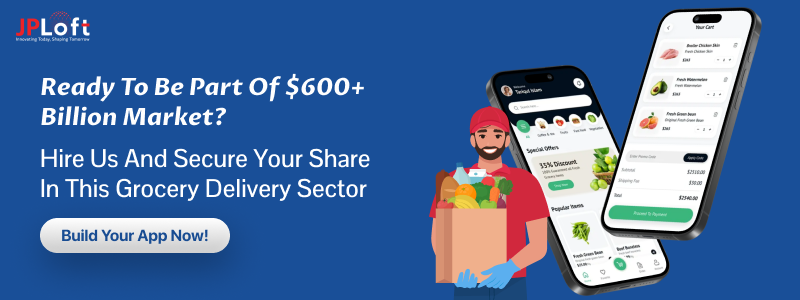
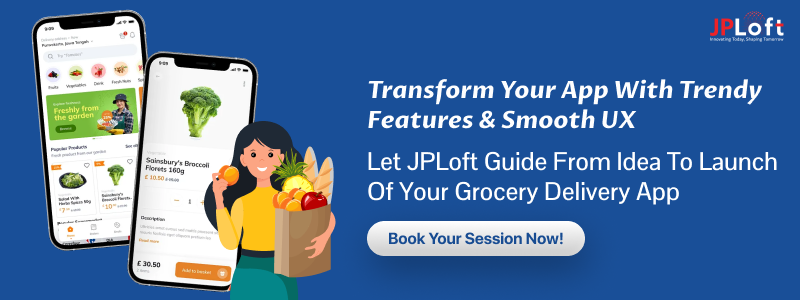

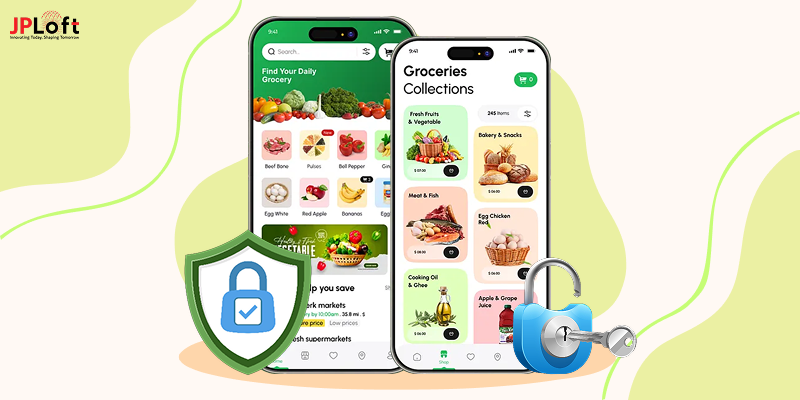
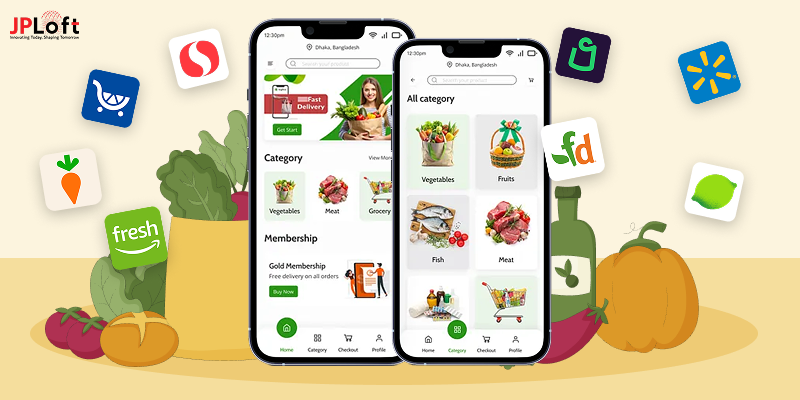
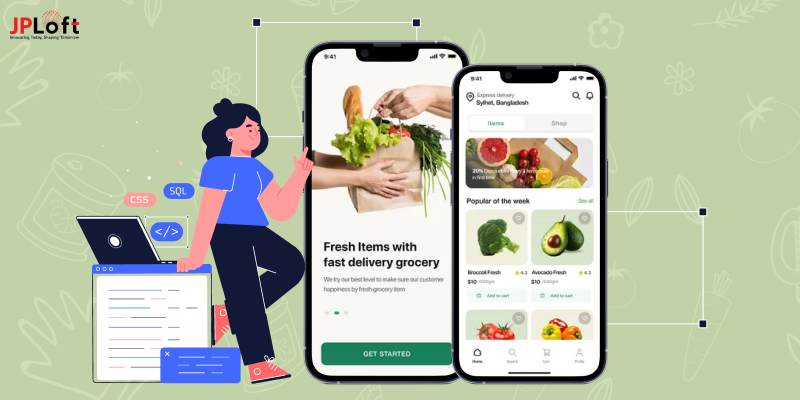


Share this blog